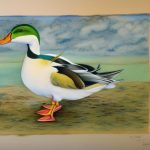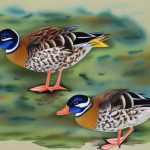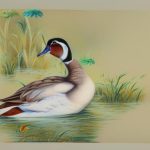Call ducks, also known as decoy ducks, are a small breed of domestic duck that originated in the Netherlands in the 1600s. They were originally bred to lure wild ducks into traps or nets, hence the name “decoy ducks.” Call ducks were prized for their small size and distinctive call, which made them excellent decoys for attracting wild ducks. Over time, their role as decoy ducks diminished, and they became popular as ornamental and exhibition birds.
Call ducks were first introduced to England in the mid-1800s, where they quickly gained popularity among breeders and enthusiasts. They were selectively bred for their small size, distinctive call, and attractive plumage, leading to the development of various color varieties. Call ducks were officially recognized by the American Poultry Association in 1874 and have since become a popular breed among duck enthusiasts and exhibitors.
Today, call ducks are valued for their charming appearance, small size, and friendly disposition. They are often kept as pets, raised for exhibition, or used as breeding stock for other duck breeds. Their rich history and unique characteristics make them a fascinating breed to study and raise.
Table of Contents
Key Takeaways
- Call ducks were originally bred in the Netherlands in the 1600s as decoy ducks for hunters.
- When selecting breeding stock, look for ducks with good conformation, size, and coloration, as well as a friendly and calm temperament.
- Provide breeding call ducks with a safe and secure environment that includes access to water for swimming and foraging.
- Breeding techniques for call ducks include natural mating, artificial insemination, and egg incubation.
- Ducklings should be kept warm, dry, and well-fed, with access to water for swimming and foraging as they grow.
- Regular health checks, proper nutrition, and a clean environment are essential for the overall wellness of call ducks.
- When selling call duck offspring, consider marketing them through online platforms, local farm markets, and social media to reach potential buyers.
Selecting Breeding Stock
When selecting breeding stock for call ducks, it is important to choose birds that exhibit the desired traits and characteristics of the breed. Look for ducks that are small in size, with a compact body, short bill, and a distinctive “call” that is loud and clear. The plumage should be vibrant and well-defined, with no signs of moulting or feather damage. It is also important to consider the temperament of the birds, as call ducks are known for their friendly and sociable nature.
When choosing breeding stock, it is advisable to select birds from reputable breeders or sources with a proven track record of breeding healthy and high-quality call ducks. Avoid birds that show signs of illness or deformities, as these traits can be passed on to future generations. It is also important to consider genetic diversity when selecting breeding stock, as inbreeding can lead to health issues and reduced fertility in offspring.
By carefully selecting breeding stock that meets the breed standard and exhibits the desired traits, breeders can improve the overall quality of their call duck flock and produce offspring that are healthy, vibrant, and true to the breed’s characteristics.
Housing and Environment for Breeding Call Ducks
Proper housing and environment are essential for breeding call ducks. Call ducks are small in size and can be kept in relatively small enclosures, but it is important to provide them with adequate space to move around and exercise. A secure and predator-proof enclosure is essential to protect the ducks from potential threats such as foxes, raccoons, and birds of prey.
The enclosure should include a sheltered area for nesting and roosting, as well as access to clean water for swimming and bathing. Call ducks are waterfowl and require access to water for grooming and maintaining their plumage. A shallow pond or water feature can provide the ducks with a natural environment to thrive and exhibit their natural behaviors.
The enclosure should also provide protection from extreme weather conditions, such as heat, cold, wind, and rain. Adequate ventilation is important to prevent moisture buildup and respiratory issues in the ducks. Providing nesting boxes or shelters can encourage breeding behavior and provide a safe space for hens to lay and incubate their eggs.
By creating a suitable housing and environment for breeding call ducks, breeders can ensure the health, well-being, and reproductive success of their flock.
Breeding Techniques and Practices
Breeding call ducks requires careful planning, observation, and management to ensure successful reproduction and healthy offspring. Breeding season for call ducks typically begins in late winter or early spring when daylight hours increase, triggering hormonal changes that stimulate mating behavior. It is important to provide a balanced diet rich in nutrients to support the reproductive health of breeding pairs.
Breeding call ducks can be achieved through natural mating or artificial insemination, depending on the breeder’s preferences and goals. Natural mating allows ducks to exhibit their natural behaviors and preferences for selecting mates, while artificial insemination provides greater control over genetic pairings and breeding outcomes.
Observing mating behavior and monitoring egg production can help breeders identify successful pairings and fertile eggs. It is important to collect eggs regularly and store them in a cool, humid environment until they are ready for incubation. Incubating call duck eggs requires careful temperature and humidity control to ensure proper development and hatching of healthy ducklings.
By implementing effective breeding techniques and practices, breeders can maximize reproductive success, genetic diversity, and overall quality of their call duck flock.
Caring for Ducklings
Caring for call ducklings requires attention to detail, patience, and a nurturing environment to support their growth and development. Newly hatched ducklings should be kept in a warm, draft-free brooder with access to clean water, balanced feed, and supplemental heat to maintain their body temperature. Providing a safe and stimulating environment can encourage natural behaviors such as feeding, drinking, preening, and socializing.
It is important to monitor the health and well-being of ducklings regularly, checking for signs of illness or distress. Proper nutrition is essential for supporting the growth and development of ducklings, providing a balanced diet rich in protein, vitamins, and minerals to support bone development, muscle growth, and overall health.
As ducklings grow, they will require access to outdoor space for exercise, exploration, and natural behaviors such as swimming and foraging. Introducing ducklings to water at an early age can help them develop their natural instincts for swimming and diving. Providing enrichment such as toys, treats, and natural materials can stimulate their curiosity and provide mental stimulation.
By providing attentive care, proper nutrition, and a stimulating environment, breeders can ensure the health, well-being, and socialization of call ducklings as they grow into healthy adult birds.
Health and Wellness Considerations

Maintaining the health and wellness of call ducks is essential for ensuring their long-term well-being and reproductive success. Regular health checks can help identify potential issues such as parasites, respiratory infections, or injuries that require treatment or intervention. Providing a clean environment with access to fresh water, balanced feed, and natural foraging opportunities can support the overall health of call ducks.
Preventative measures such as vaccination, parasite control, and biosecurity protocols can help minimize the risk of disease outbreaks and maintain a healthy flock. It is important to monitor the behavior and condition of individual birds regularly to identify any changes that may indicate underlying health issues.
Proper nutrition is essential for supporting the overall health and vitality of call ducks. Providing a balanced diet rich in protein, vitamins, minerals, and essential nutrients can support reproductive health, feather quality, immune function, and overall vitality.
By prioritizing the health and wellness of call ducks through attentive care, preventative measures, and proper nutrition, breeders can ensure the long-term well-being of their flock.
Tips for Selling and Marketing Call Duck Offspring
Selling call duck offspring requires careful planning, marketing strategies, and networking within the poultry community. Establishing a strong online presence through social media platforms, websites, or online marketplaces can help reach potential buyers interested in acquiring call ducklings or breeding stock.
Networking with local poultry clubs, breeders’ associations, or agricultural fairs can provide opportunities to showcase call duck offspring at exhibitions or sales events. Building relationships with potential buyers through open communication, transparency about breeding practices, and providing support after the sale can help establish trust and credibility within the poultry community.
Highlighting the unique characteristics of call ducks such as their small size, charming appearance, friendly disposition, and distinctive call can attract potential buyers interested in raising them as pets or exhibition birds. Providing accurate information about the breed’s history, care requirements, and breeding practices can educate potential buyers about the value of call duck offspring.
Offering personalized customer service such as providing care guidelines, answering questions about raising call ducks, or offering mentorship to new breeders can enhance the buying experience and build long-term relationships with customers.
By implementing effective selling and marketing strategies that highlight the unique qualities of call duck offspring while providing exceptional customer service, breeders can attract potential buyers interested in acquiring high-quality call ducklings or breeding stock.
If you’re interested in learning more about duck breeding, you might also want to check out this informative article on how many eggs geese lay. It provides valuable insights into the breeding habits of geese, which can be helpful for understanding the broader context of waterfowl breeding.
FAQs
What is call duck breeding?
Call duck breeding is the process of selectively breeding call ducks to produce offspring with desired traits such as size, color, and conformation.
What are call ducks?
Call ducks are a small breed of domestic duck that are known for their distinctive “call” or “whistle” sound. They are often kept as pets or for exhibition purposes.
What are some common traits that breeders aim for in call duck breeding?
Breeders may aim for traits such as a small and compact body, a specific color pattern or markings, a certain head shape, and a clear and distinct call.
What are some challenges in call duck breeding?
Challenges in call duck breeding may include maintaining genetic diversity, preventing inbreeding, and managing health issues such as leg problems and reproductive issues.
What are some tips for successful call duck breeding?
Successful call duck breeding may involve careful selection of breeding stock, providing a balanced diet, ensuring proper housing and space, and regular health checks by a veterinarian.
Meet Walter, the feathered-friend fanatic of Florida! Nestled in the sunshine state, Walter struts through life with his feathered companions, clucking his way to happiness. With a coop that’s fancier than a five-star hotel, he’s the Don Juan of the chicken world. When he’s not teaching his hens to do the cha-cha, you’ll find him in a heated debate with his prized rooster, Sir Clucks-a-Lot. Walter’s poultry passion is no yolk; he’s the sunny-side-up guy you never knew you needed in your flock of friends!







